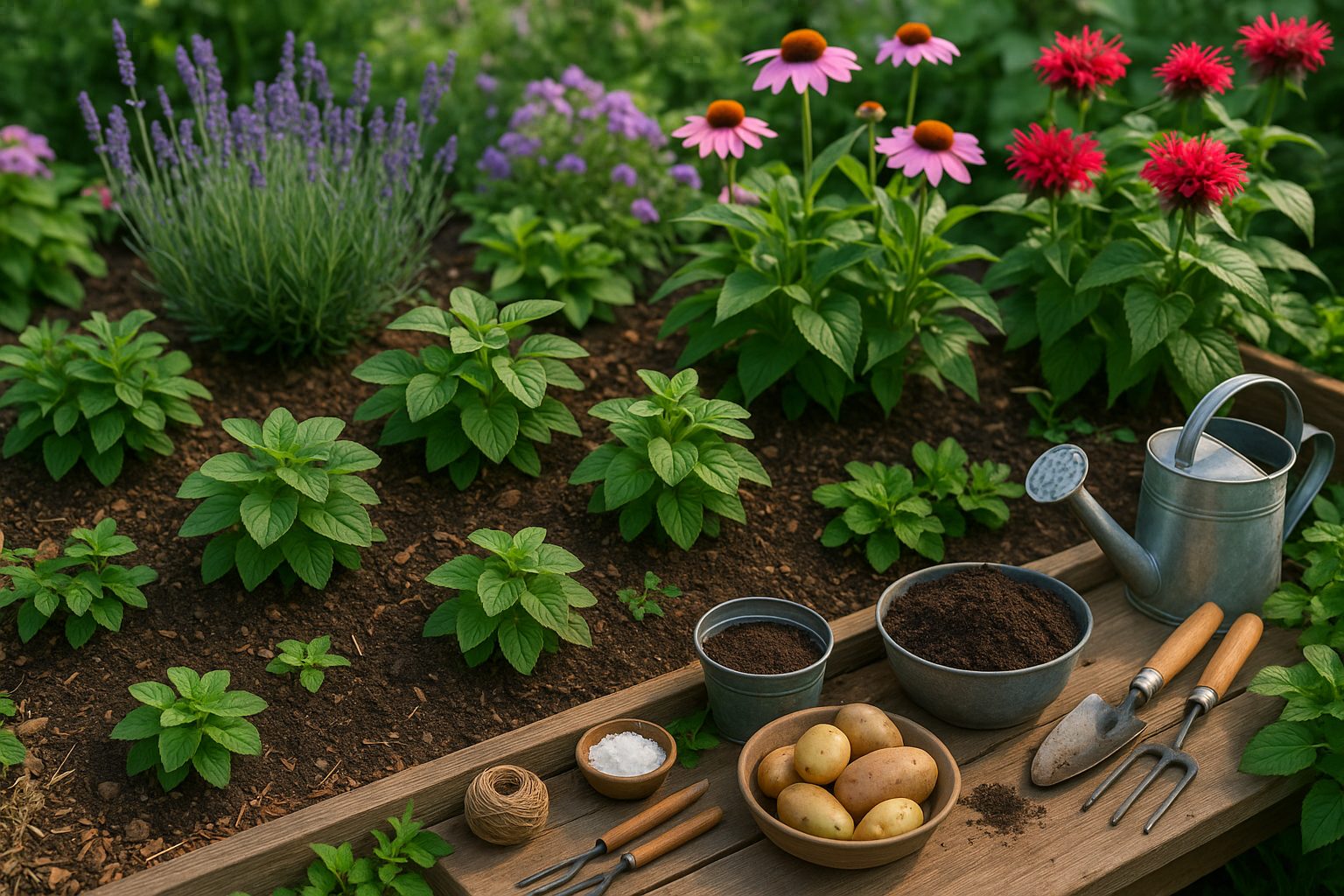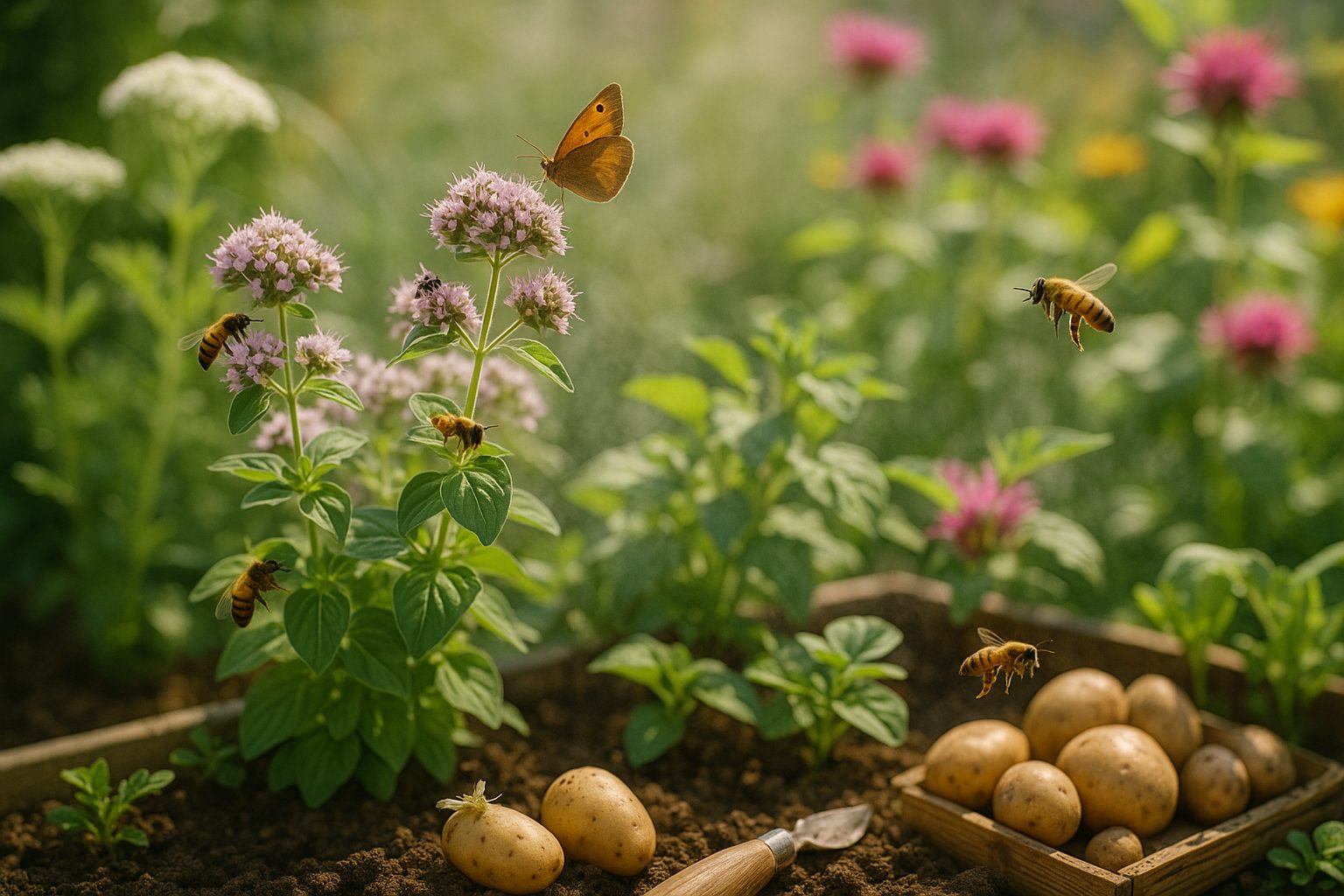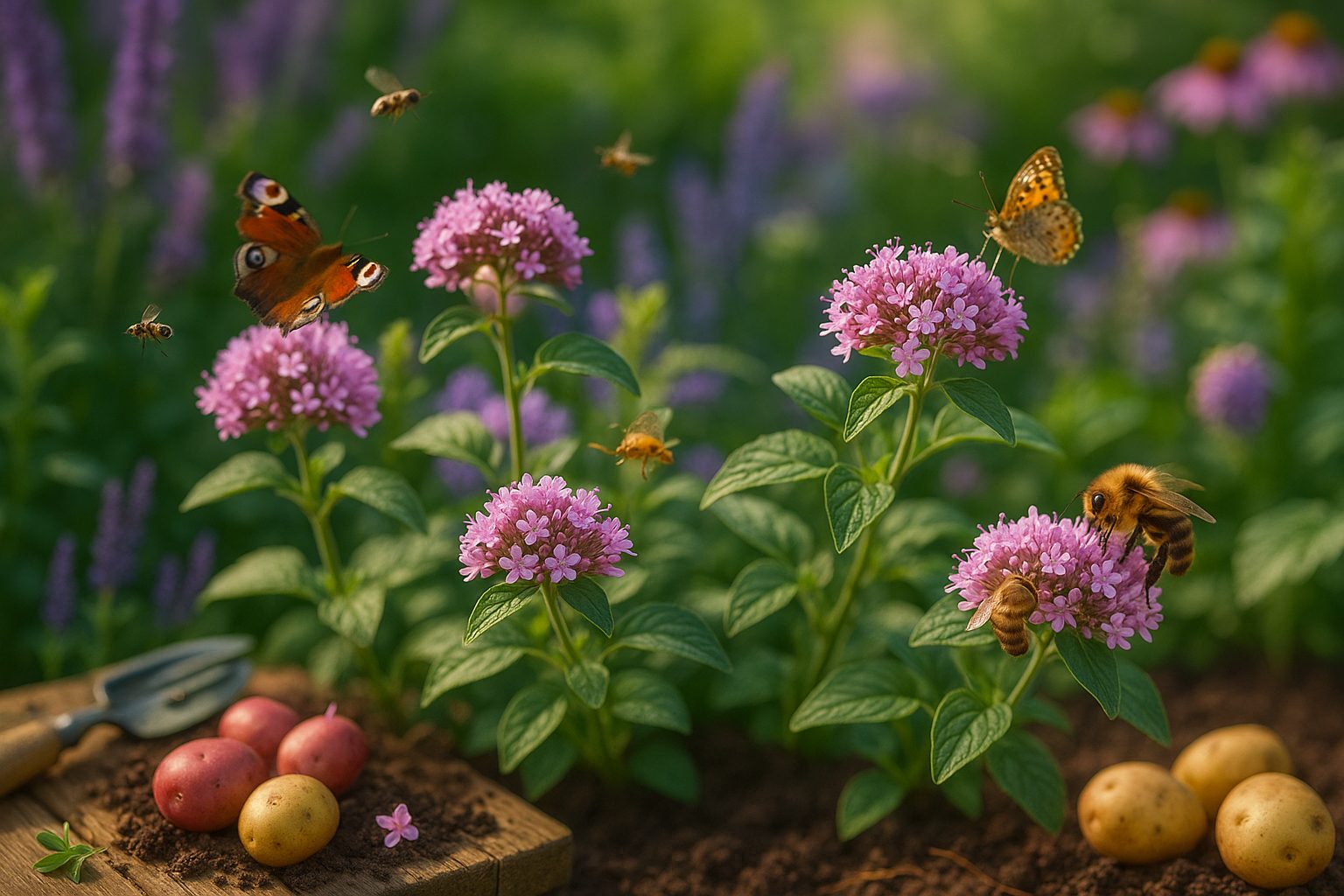Introduction
Mexican oregano pollinators are a perfect example of how garden choices can significantly impact local ecosystems. Unlike the familiar Mediterranean oregano, Mexican oregano (Lippia graveolens) is a hardy, aromatic shrub native to Mexico and the American Southwest. Its leaves offer a robust, citrusy flavor, but what really sets it apart is its abundance of tiny white to pale lavender flowers that bloom throughout the warm months.
These nectar-rich blossoms attract bees, butterflies, and even beneficial moths, making Mexican oregano not just a culinary favorite but also a crucial ally for pollinator health. If you want a garden buzzing with life, planting this drought-tolerant herb is a smart choice—especially in areas prone to heat and drought where pollinator food sources are scarce.
In this article, we’ll show you how to grow Mexican oregano with pollinators in mind, offer tips to keep your plants thriving, and explain why just one shrub can make a big difference for native bees and butterflies. Whether you have a sprawling garden bed or a sunny patio container, supporting these vital insects starts with the right plant choices.
Choosing the Right Location and Soil for Mexican Oregano Pollinators

Mexican oregano thrives in environments similar to its native arid and semi-arid regions of Mexico and the southwestern United States. This hardy herb flourishes in full sunlight, needing at least six to eight hours of direct sun each day, making it perfect for sunny garden beds or patios. Its roots dislike soggy conditions, so well-draining soil is essential—standing water can quickly cause root rot.
Sandy or gritty soils, like those found in desert landscapes, are ideal for Mexican oregano, although it will adapt to light loams as long as drainage is good. To evaluate your garden, choose the sunniest spot and observe how the soil handles watering—if puddles linger, consider mixing in coarse sand or small gravel to improve drainage.
If your garden has heavy clay soil or limited light, raising beds or using containers can be effective solutions. Container gardening works well for patios or small spaces. Select pots with drainage holes and use a cactus or succulent potting mix to replicate dry, porous soil conditions. Keep containers elevated or on stands so excess water can drain freely.
By matching your planting location and soil to Mexican oregano’s needs, you’ll create a thriving environment that attracts butterflies, bees, and other mexican oregano pollinators right to your garden.
Growing Mexican Oregano: Planting and Propagation Tips
Starting Mexican oregano for pollinators is a fun and rewarding process with multiple planting options, including seeds, cuttings, or nursery plants. To grow from seed, start indoors 6-8 weeks before the last frost. Sow seeds on the surface of moist, well-draining potting mix, pressing them lightly since they need sunlight to germinate. Keep the temperature around 70°F, and expect germination in about two weeks. Once the weather warms up, transplant the seedlings outdoors.
For propagation by cuttings, snip 4-6 inch stems from a healthy, established plant in late spring or early summer. Remove leaves from the bottom two inches, dip the cut ends in organic rooting hormone, and plant them in a pot with damp, sandy soil. Keep the soil moist and place the pot in bright, indirect light until roots develop—usually within a month. If you prefer nursery plants, select vibrant, green starters and transplant them after your area’s last frost date.
When planting outdoors, choose a sunny location with well-draining soil, as Mexican oregano thrives in warm conditions and can tolerate drought once established. Space plants 18 to 24 inches apart to ensure good airflow and allow pollinators easy access to the blooms from all sides. Water new plantings deeply after transplanting, then reduce watering frequency as the plants establish—typically watering once every 10 to 14 days, depending on rainfall and soil type.
To support Mexican oregano pollinators like bees and butterflies, avoid synthetic fertilizers and pesticides that can harm these beneficial visitors. Instead, enrich soil with compost and mulch using organic materials to retain moisture and suppress weeds. Manage pests by hand or with natural remedies like neem oil or insecticidal soap, applying them only in the evening when pollinators are inactive. These mindful, organic gardening practices help keep Mexican oregano pollinators safe while fostering a thriving, fragrant pollinator garden.
Caring for Your Mexican Oregano: Maintenance Through the Seasons
Proper care of your Mexican oregano is essential for supporting a vibrant garden full of mexican oregano pollinators year-round. Start with a consistent watering routine: during the first growing season, water deeply once a week to help roots establish, but ensure the soil drains well since Mexican oregano dislikes soggy conditions. Once mature, this hardy perennial tolerates drought, so you can cut back watering, only soaking when dry spells persist.
Mulching is highly beneficial—apply a 2-3 inch layer of organic mulch like shredded bark or leaf litter around the base in spring. This helps retain moisture, suppress weeds, and regulate root temperature, all of which promote healthy growth.
Pruning is key to keeping your Mexican oregano bushy and productive, leading to more blooms and attracting pollinators such as butterflies, bees, and hummingbirds. In spring, trim back about one-third of the plant, focusing on spindly or woody stems to encourage dense new growth. Throughout the growing season, pinch back stem tips to promote branching and maximize flowering. After the main bloom, deadhead spent flowers to encourage a second wave of blossoms, keeping your garden buzzing with pollinator activity.
As temperatures drop, especially in frost-prone areas, extra protection helps your plant thrive year after year. In autumn, apply a thicker mulch layer—up to four inches—to insulate roots from freezing. For young or container-grown plants, move them to sheltered spots or cover with frost cloths on cold nights. If your Mexican oregano is potted, consider relocating it indoors or to a sunny garage during winter to improve survival.
Sturdy, well-maintained plants reward your care with a profusion of nectar-rich blooms each season, making your garden a magnet for beneficial mexican oregano pollinators.
How Mexican Oregano Benefits Bees, Butterflies, and Other Pollinators

Mexican oregano’s aromatic foliage and long flowering period make it a powerhouse for supporting pollinators in your garden. Throughout spring and summer, this hardy herb continuously produces delicate clusters of flowers rich in both nectar and pollen. These blooms attract native bees—such as sweat bees and leafcutter bees—that rely on them as steady food sources during the warm months.
Honey bees often visit Mexican oregano, collecting nectar that sustains hives and aids honey production. Butterflies, including swallowtails and painted ladies, frequently flutter among the blossoms, sipping nectar and transferring pollen as they move from flower to flower, contributing to plant reproduction. Even hummingbirds are drawn to the abundant flowers, hovering for a quick drink and providing vital pollination services in the process.
The ecological impact of these visits is significant: regular pollinator activity boosts biodiversity, strengthens plant communities, and encourages a thriving garden ecosystem. To enhance your pollinator plot further, try planting Mexican oregano alongside other nectar-rich species like salvia, lavender, or native milkweed. These companion plants offer overlapping bloom times and varied flower structures, attracting a wider range of pollinating insects and birds throughout the season.
This thoughtful combination creates a visually appealing, ever-buzzing sanctuary that supports pollinator populations and helps sustain their essential roles year-round.
Harvesting, Using, and Maintaining Blooms for Pollinators
When growing Mexican oregano for pollinators, it’s important to balance your harvest with the needs of bees, butterflies, and other beneficial insects that depend on its fragrant blooms. To avoid disrupting these valuable visitors, try to harvest only the leaves and avoid cutting stems with active flowers. Use sharp, clean scissors or pruning shears to snip a few leaves from each stem, preferably from the lower parts of the plant where blossoms haven’t formed.
Harvesting early in the morning, before pollinators become most active, minimizes disturbance and keeps both your plant and local insect population happy. If you need flowering sprigs for culinary or medicinal purposes, focus on stems where blooms are fading or past their peak—this allows pollinators to finish gathering nectar and encourages the plant to produce new flower spikes.
To keep Mexican oregano blooming abundantly for as long as possible, regular but minimal harvesting is key. Avoid cutting back large sections at once; instead, stagger your leaf and sprig collection every two to four weeks. After the initial bloom, deadhead spent flowers by pinching them off—this prevents seed formation and encourages new blossoms, ensuring a continuous food source for pollinators.
Providing adequate water during dry spells and applying a light layer of compost or organic mulch around the roots supports healthy, vigorous growth. Finally, consider leaving the last round of blooms on the plant at the end of the growing season so pollinators can enjoy a final nectar feast and birds can forage the seeds. This mindful approach makes your Mexican oregano a thriving resource for both your kitchen and your garden’s pollinator visitors.
Common Problems and Eco-Friendly Solutions
Mexican oregano is generally a hardy, low-maintenance plant, but it can sometimes face challenges that affect its health and its appeal to mexican oregano pollinators. Common pests like aphids and spider mites may cluster on the leaves, sucking sap and stressing the plant. Instead of chemical sprays, try blasting pests off with a strong jet of water or use insecticidal soap made from natural ingredients—both are safe for pollinators.
Fungal diseases, often caused by soggy soil or poor air circulation, can lead to yellowing or wilted foliage. To fix this, ensure your plant has good drainage, proper spacing for airflow, and water only when the soil feels dry. Mexican oregano also dislikes over-fertilization, which can produce lush leaves but fewer blooms, reducing its attractiveness to pollinators. Stick to a light application of compost in spring and avoid chemical fertilizers.
If your plant isn’t flowering, check its sun exposure—Mexican oregano needs at least six hours of direct sunlight daily to thrive and bloom. Trim back leggy growth to encourage bushiness and more blooms. Regularly deadhead spent flowers to tidy the plant and promote new blossoms, helping keep your garden a welcoming haven for bees, butterflies, and other mexican oregano pollinators.
Conclusion
Mexican oregano is a standout choice for anyone looking to support local pollinators—the plant’s abundant blooms attract bees, butterflies, and even hummingbirds throughout the season. Beyond its beauty, it thrives with minimal care, tolerating heat, drought, and poor soil conditions. By planting Mexican oregano, you not only enjoy aromatic foliage and vibrant flowers but also help sustain essential pollinator populations right in your backyard. Interested in expanding your impact? Explore our other articles on creating pollinator-friendly gardens and choosing native plants to transform your outdoor space into a buzzing haven for beneficial wildlife.
